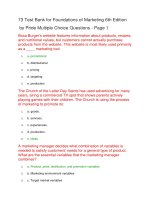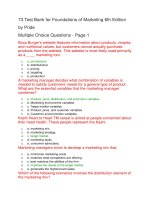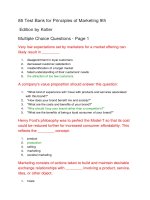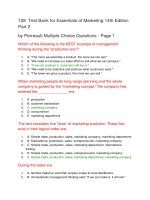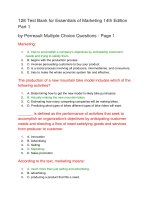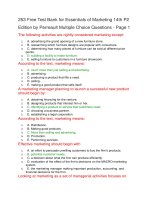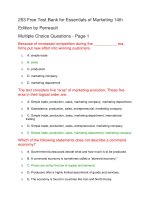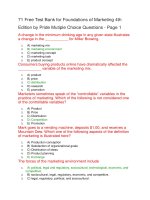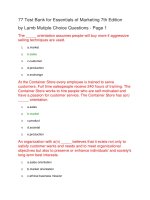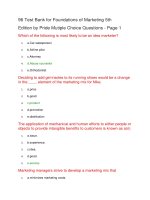96 test bank for foundations of marketing 5th
Bạn đang xem bản rút gọn của tài liệu. Xem và tải ngay bản đầy đủ của tài liệu tại đây (130.25 KB, 30 trang )
96 Test Bank for Foundations of Marketing 5th
Edition by Pride Mutiple Choice Questions - Page 1
Which of the following is most likely to be an idea marketer?
1.
a.Car salesperson
2.
b.Airline pilot
3.
c.Attorney
4.
d.Abuse counselor
5.
e.Orthodontist
Deciding to add gel insoles to its running shoes would be a change
in the ____ element of the marketing mix for Nike.
1.
a.price
2.
b.good
3.
c.product
4.
d.promotion
5.
e.distribution
The application of mechanical and human efforts to either people or
objects to provide intangible benefits to customers is known as a(n)
1.
a.issue.
2.
b.experience.
3.
c.idea.
4.
d.good.
5.
e.service.
Marketing managers strive to develop a marketing mix that
1.
a.minimizes marketing costs.
2.
b.matches what competitors are offering.
3.
c.best matches the abilities of the firm.
4.
d.matches the needs of the target market.
5.
e.generates the highest level sales.
A marketing manager decides what combination of variables is
needed to satisfy customers' needs for a general type of product.
What are the essential variables that the marketing manager
combines?
1.
a.Product, price, distribution, and promotion variables
2.
b.Marketing environment variables
3.
c.Product and promotion variables
4.
d.Product, price, and customer variables
5.
e.Product, price, customer, and promotion variables
A physical product you can touch is a(n)
1.
a.service.
2.
b.good.
3.
c.idea.
4.
d.concept.
5.
e.philosophy.
Making modifications to packaging or brand names involves the
____ component of the marketing mix.
1.
a.price
2.
b.promotion
3.
c.market
4.
d.distribution
5.
e.product
Organizations should define themselves not according to the
products they produce but according to
1.
a.how profitable they are.
2.
b.the price of their stock.
3.
c.the abundance of their product selection.
4.
d.how they treat employees.
5.
e.how they satisfy customers.
The focal point of all marketing activities is
1.
a.products.
2.
b.the marketing mix.
3.
c.profits.
4.
d.sales.
5.
e.customers.
The primary value that a marketer expects to receive from a
customer in an exchange relationship is
1.
a.the price charged for the product.
2.
b.customer satisfaction.
3.
c.references to other potential customers.
4.
d.quality merchandise that meets expectations.
5.
e.few returns of the merchandise purchased.
Kashi Heart to HeartTM cereal is aimed at people concerned about
their heart health. These people represent the Kashi
1.
a.marketing mix.
2.
b.marketing strategy.
3.
c.target market.
4.
d.marketing tactic.
5.
e.consumer advocates.
The definition of marketing implies that ____ should receive
benefits from exchange relationships.
1.
a.only customers
2.
b.only businesses
3.
c.company management
4.
d.both customers and businesses
5.
e.only the most important customers
When Burger King offers 99-cent Whoppers to increase store traffic,
it is altering which aspect of the marketing mix?
1.
a.Price
2.
b.Promotion
3.
c.Distribution
4.
d.Product
5.
e.Target market
Rob Donaldson runs a successful wholesale business that sells
equipment to restaurants throughout the Midwest. He is considering
purchasing his own fleet of trucks to deliver the equipment instead
of relying on a shipper as he is currently doing. This most closely
represents a decision about
1.
a.which market he should target.
2.
b.the best way to distribute his products.
3.
c.how to effectively promote his business.
4.
d.the product he provides to his customer.
5.
e.which supplier he should use.
Which of the following scenarios involves the distribution element of
the marketing mix?
1.
2.
a.Deciding whether or not a certain product should continue to be sold
b.Determining whether an advertising message would be more effective on
television or in magazines
3.
c.Choosing between a company jet or the airlines for executive travel
4.
d.Deciding whether or not to have retail outlets in addition to a website
5.
e.Developing a new warranty policy for an existing product
The marketing mix is built around the
1.
a.product.
2.
b.company.
3.
c.customer.
4.
d.employee.
5.
e.retail outlet.
SunnyD is aimed at mothers with children under age twelve. These
mothers represent SunnyD's
1.
a.target market.
2.
b.consumer advocates.
3.
c.marketing strategy.
4.
d.marketing mix.
5.
e.marketing tactic.
Changing the hours of operation for a service business involves the
____ component of the marketing mix.
1.
a.product
2.
b.price
3.
c.distribution
4.
d.promotion
5.
e.marketing concept
Marketing is the process of
1.
a.promoting products through personal selling and advertising to develop and
maintain favorable relationships with customers and stakeholders.
2.
b.creating, distributing, promoting, and pricing products to facilitate satisfying
exchange relationships with customers and to develop and maintain favorable
relationships with stakeholders in a dynamic environment.
3.
4.
5.
c.delivering a standard of living to a society.
d.creating, distributing, promoting, and pricing goods, services, and ideas to
facilitate the achievement of the firm's objectives.
e.focusing on customers' needs.
The three basic forms that a product can take are
1.
a.markets, products, and images.
2.
b.goods, ideas, and intangibles.
3.
c.brands, services, and tangibles.
4.
d.services, ideas, and goods.
5.
e.ideas, services, and things.
The element of the marketing mix used to increase awareness of a
product or company is
1.
a.communication.
2.
b.product.
3.
c.price.
4.
d.distribution.
5.
e.promotion.
The Church of the Latter Day Saints has used advertising for many
years to market its
1.
a.goods.
2.
b.services.
3.
c.experiences.
4.
d.production.
5.
e.ideas.
Distribution, price, promotion, and product are all elements of
1.
a.marketing strategy.
2.
b.the marketing mix.
3.
c.a target market.
4.
d.a consumer good.
5.
e.a business strategy.
Consumers buying products online have dramatically affected the
____ variable of the marketing mix.
1.
a.product
2.
b.price
3.
c.distribution
4.
d.research
5.
e.promotion
Issues of inventory levels and storage costs are both concerns
relating to the ____ variable of the marketing mix.
1.
a.distribution
2.
b.product
3.
c.exchange
4.
d.price
5.
e.promotion
Which of the following companies is the best example of a service
marketer?
1.
a.FedEx
2.
b.Sony
3.
c.Abercrombie & Fitch
4.
d.The Democratic Party
5.
e.General Electric
Mothers Against Drunk Driving (MADD) is a group that works to
change attitudes and laws about driving under the influence of
alcohol. MADD primarily markets
1.
a.goods.
2.
b.ideas.
3.
c.services.
4.
d.political figures.
5.
e.applications.
Boca Burger's website features information about products, recipes,
and nutritional values, but customers cannot actually purchase
products from the website. This website is most likely used primarily
as a ____ marketing tool.
1.
a.promotional
2.
b.distributional
3.
c.pricing
4.
d.targeting
5.
e.production
When DuPont develops new carpet fibers that are highly stainresistant and durable, it must educate consumers about the
product's benefits. This calls for activity in which of the following
marketing mix variables?
1.
a.Price
2.
b.Promotion
3.
c.Distribution
4.
d.Product
5.
e.Packaging
A target market
1.
2.
a.involves a large number of customers.
b.is a specific group of customers on whom a company focuses its marketing
efforts.
3.
c.already has several competitors vying for customers' business.
4.
d.is the same as a salesperson's prospective client list.
5.
e.is a customer group classified as people with similar demographic
characteristics.
The product variable of the marketing mix can include all of the
following except
1.
a.creation of brand names.
2.
b.consumer perception of the product price.
3.
c.development of product packaging.
4.
d.warranty issues.
5.
e.repair services.
96 Free Test Bank for Foundations of Marketing 5th
Edition by Pride Mutiple Choice Questions - Page 2
Which of the following best describes the acceptance of the
marketing concept by American organizations?
1.
a.The marketing concept has yet to be fully accepted by all organizations.
2.
b.All organizations fully utilize the marketing concept to run their businesses.
3.
c.Nearly half of all organizations are still in the sales orientation and have not
implemented the marketing concept.
4.
d.Most organizations have really not accepted the marketing concept because
of its many costs and problems.
5.
e.Although American organizations fully accept the marketing concept, many
foreign companies do not.
For an exchange to occur, four conditions must exist: first, two or
more individuals, groups, or organizations must participate, and
each must possess "something of value" that the other desires;
second, the exchange must provide a benefit or satisfaction to both
parties; third, each must have confidence in the promise of the
"something of value" held by the other; and fourth,
1.
a.the parties must agree to participate in the trading of "something of value."
2.
b.to build trust, parties to the exchange must meet expectations.
3.
c.both parties must participate in the trading of the "something of value."
4.
d.one party must be willing to compromise.
5.
e.one party must have sufficient bank credit to finance the exchange.
When Wonder introduced a new bread made with white whole
wheat in response to customer demand, it was following which of
the following philosophies?
1.
a.selling concept
2.
b.production concept
3.
c.marketing concept
4.
d.customer concept
5.
e.retailing concept
The marketing concept affects
1.
a.just the marketing department.
2.
b.all organizational activities.
3.
c.only marketing and finance.
4.
d.only production and marketing.
5.
e.few decisions in an organization.
Which of the following best characterizes the forces of the
marketing environment?
1.
a.The forces are relatively stable over time and are interrelated with one
another.
2.
b.There are few overlapping aspects of these forces; therefore, a change in
one is unlikely to result in a change in another.
3.
c.The various forces ensure that the marketing environment will remain fairly
certain in the future.
4.
d.These forces change dramatically over time, but a change in one force is
unlikely to impact another force.
5.
e.The forces change dramatically and quickly, and a change in one force is
likely to affect the other forces.
Mark goes to a vending machine, deposits $1.00, and receives a
Sprite. Which one of the following aspects of the definition of
marketing is illustrated here?
1.
a.Production conception
2.
b.Satisfaction of organizational goals
3.
c.Distribution of ideas
4.
d.Product planning
5.
e.Exchange
Which of the following statements about marketing environment
forces is correct?
1.
a.They influence customers by affecting their lifestyles, standards of living,
and preferences and needs for products.
2.
b.They do not influence customers' reactions to a firm's marketing mix.
3.
c.They fluctuate slowly and thereby create threats to a firm's marketing mix.
4.
d.They never fluctuate quickly.
5.
e.They do not influence the way a marketing manager performs certain
marketing activities.
The Jackson Hewitt company wants to adopt the marketing concept
as a business philosophy. To be consistent with this decision, it
should adopt which of the following philosophies?
1.
a.The customer is always right.
2.
b.Making money is our business.
3.
c.Sell, sell, sell.
4.
d.Keep prices low.
5.
e.Focus on today.
The marketing concept is best defined as
1.
a.a second definition of marketing.
2.
b.a philosophy stating that an organization should try to satisfy customers'
needs through a coordinated set of activities that allows the organization to
achieve its goals.
3.
c.the performance of business activities that direct the flow of goods and
services from producer to customer or user.
4.
d.a philosophy stating that an organization should attempt to accomplish its
goals with no regard for the needs of customers.
5.
e.the inclusion of marketing activities in the activities of an organization.
The marketing environment is best described as being
1.
a.composed of controllable variables.
2.
b.composed of variables independent of one another.
3.
c.an indirect influence on the performance of marketing activities.
4.
d.dynamic and changing.
5.
e.slow, with infrequent fluctuations.
In managing customer relationships, the three primary ways profits
can be obtained are by
1.
a.acquiring new customers, enhancing the profitability of new customers, and
shortening the duration of relationships with existing customers.
2.
b.enhancing the profitability of existing customers, eliminating customers who
provide smaller profits, and finding new customers.
3.
c.extending the length of relationships with customers, cutting organizational
costs, and enhancing the profitability of new customers.
4.
d.eliminating long-term customers who have decreased purchases, finding
new customers, and increasing sales to existing customers.
5.
e.enhancing the profitability of existing customers, extending the duration of
relationships with customers, and obtaining new customers.
A change in the minimum drinking age in any given state illustrates
a change in the ____ for Miller Brewing.
1.
a.marketing mix
2.
b.marketing environment
3.
c.marketing concept
4.
d.marketing task
5.
e.product concept
American Express implements a program of calling its current
cardholders to find out what changes they would like to see in the
services provided. The firm is exhibiting characteristics associated
with which of the following orientations?
1.
a.Production
2.
b.Sales
3.
c.Market
4.
d.Social
5.
e.Development
The marketing concept is a management philosophy that affects
1.
a.only marketing activities.
2.
b.all efforts of the organization.
3.
c.mainly the efforts of sales personnel.
4.
d.mainly customer relations.
5.
e.only business organizations.
Which one of the following statements by a company president best
reflects the marketing concept?
1.
a.We have organized our business to make certain that customers get what
they want.
2.
b.We believe that the marketing department must organize to sell what we
produce.
3.
c.We have organized an aggressive sales force in our company to promote
our products.
4.
d.We try to produce only high-quality, technically efficient products.
5.
e.We try to encourage company growth.
The concept of "exchange" is fundamental to the definition of
marketing. What is the best description of exchange?
1.
2.
3.
a.Activities that are performed primarily by producers and manufacturers
b.Development of products, distribution channels, promotional strategies, and
pricing objectives to satisfy customer requirements
c.Transfer of products in return for monetary considerations
4.
d.Provision or transfer of goods, services, or ideas in return for something of
value
5.
e.Transfer of products that takes place only between for-profit organizations
According to the marketing concept, an organization should try to
1.
2.
a.consider short-run objectives and cash flow needs before developing new
products.
b.define its business as "making a product."
3.
c.provide products that satisfy customers' needs and allow the organization to
achieve its goals.
4.
d.put most of its emphasis on marketing activities and be less concerned with
finance, accounting, and personnel.
5.
e.view selling activities as the major means of increasing profits.
A market orientation is an organization-wide effort that includes all
of the following activities except
1.
a.researching customers' needs.
2.
b.focusing on the marketing department only.
3.
c.generating marketing intelligence for use in the organization.
4.
d.being responsive to customers' ever-changing wants and needs.
5.
e.disseminating marketing intelligence across departments within the
organization.
The forces of the marketing environment include
1.
2.
a.political, legal and regulatory, sociocultural, technological, economic, and
competitive.
b.sociocultural, legal, regulatory, economic, and competitive.
3.
c.legal, regulatory, political, and sociocultural.
4.
d.competitive and noncompetitive forces that affect most lifestyles.
5.
e.fairly static components.
U.S. Electric, the maker of a highly innovative xenon light bulb, finds
that it has excess inventory. The firm increases its advertising
budget by 50 percent and doubles its sales staff. This company is
operating as if it were in which of the following orientations?
1.
a.Production
2.
b.Sales
3.
c.Market
4.
d.Customer
5.
e.Societal
The marketing concept is
1.
a.a management philosophy.
2.
b.synonymous with exchange.
3.
c.a component of the marketing mix.
4.
d.a function of the marketing environment.
5.
e.focused solely on satisfying customer objectives.
When DataComp Corp., a producer of computer software, delayed
the introduction of its new spreadsheet program to modify the
package, its scheduled magazine advertisements announcing the
new product needed to be revised. In this case, a change in the
____ variable caused changes in the ____ variable of the marketing
mix.
1.
a.distribution; promotion
2.
b.distribution; product
3.
c.product; price
4.
d.product; promotion
5.
e.promotion; price
A marketing manager for a small computer manufacturer is
analyzing the potential effects of political, legal, sociocultural, and
economic forces on the firm's operations. The marketing manager
is examining the ____ that influence(s) the firm's strategy.
1.
a.operating situation
2.
b.marketing environment
3.
c.surroundings
4.
d.economic conditions
5.
e.trends
When Campbell's introduced a line of low-sodium soups in
response to customer demand, it was following which one of the
following philosophies?
1.
a.Selling concept
2.
b.Production concept
3.
c.Customer concept
4.
d.Marketing concept
5.
e.Retailing concept
Marketing facilitates exchange relationships between buyers and
sellers. What is marketing's intended outcome for this relationship?
1.
a.Profits for the seller
2.
b.A good bargain on the product for the buyer
3.
c.Reducing the seller's inventory
4.
d.One party having to compromise in the exchange
5.
e.Satisfaction for both the buyer and seller
The marketing concept focuses on
1.
a.achieving the goals of top executives.
2.
b.creating maximum visibility for the firm.
3.
c.maximizing sales.
4.
d.maximizing market share.
5.
e.satisfying customers' needs in a way that helps to achieve organizational
objectives.
Health Care Systems, Inc. rolls out an innovative nurse-on-call
information system available online. The product is not widely
accepted because patients don't see the need for such a service.
This situation represents a failure in which aspect of implementing
the marketing concept?
1.
a.An information system to determine customer needs
2.
b.The organizational structure
3.
c.Top-management commitment
4.
d.Technological advancement
5.
e.Scanning corporate capabilities
The marketing concept is a philosophy that states that an
organization should try to satisfy customers' needs and also
1.
a.increase market share.
2.
b.increase sales.
3.
c.achieve the organization's goals.
4.
d.produce high-quality products.
5.
e.coordinate its activities to increase production.
As the Industrial Revolution came to the United States, most firms
operated in a(n) ____ orientation.
1.
a.market
2.
b.societal
3.
c.sales
4.
d.evolutionary
5.
e.production
The forces of the marketing environment primarily affect marketers
in three ways: They influence customers by affecting their lifestyles
and preferences for products; they determine whether or how a
marketing manager can perform certain marketing activities; and
they
1.
a.affect a marketing manager's decisions and actions by influencing buyers'
reactions to the firm's marketing mix.
2.
b.dictate that changes be made to the existing marketing mix despite any
negative reactions from customers.
3.
c.make most new products obsolete very quickly so that research and
development must continually develop new products.
4.
d.cause most advertising to be ineffective at communicating product benefits
due to rapidly changing environmental forces.
5.
e.change a customer's decisions about the appropriate marketing mix for the
company and its various products.
Which of the following is essentially an uncontrollable factor in
developing a marketing mix?
1.
a.Product adaptations
2.
b.Pricing strategies
3.
c.Government regulations
4.
d.Advertising campaigns
5.
e.Retail locations
A junior marketing executive at MegaGrain Cereals suggests
increasing the package size and price of its best-selling brand
without increasing the amount of cereal inside the box. Her superior
warns that this might be a bad idea because MegaGrain's long-term
survival, like most companies, depends on
1.
a.cost-cutting measures.
2.
b.continually selling to new customers and markets.
3.
c.creating and maintaining satisfying exchange relationships.
4.
d.high-volume, low-margin sales.
5.
e.increasing shelf space for their brands.
During the Industrial Revolution demand for manufactured goods
was
1.
a.weak.
2.
b.nonexistent.
3.
c.declining.
4.
d.strong.
5.
e.mediocre.
Today, establishing long-term, mutually beneficial arrangements in
which both the buyer and seller focus on value enhancement
through the creation of more satisfying exchanges is known as
1.
a.marketing synthesis.
2.
b.relationship marketing.
3.
c.a marketing orientation.
4.
d.the marketing concept.
5.
e.strategic marketing.
StarKist Tuna announced a dolphin-safe policy and stopped buying
tuna from fishing vessels that net dolphins. This decision indicates a
response to concerns about
1.
a.target market selection.
2.
b.the marketing environment.
3.
c.the reduction of marketing costs.
4.
d.marketing mix decisions.
5.
e.efficiency in marketing activities.
Which of the following is not an example of the implementation of
the marketing concept?
1.
a.Jimmy Dean's Sausage introduces turkey sausage patties for a healthier
alternative to pork.
2.
b.Mar's Candy asks customers to vote online for a new color for its M&M's
candy.
3.
c.Burger King reduces the labor costs to produce its sausage-egg biscuits.
4.
d.Microsoft offers rewards for users who can find flaws in its new software.
5.
e.Saab introduces pop-up rollover bars in its convertibles to protect its
consumers in the event of a serious collision.
From the 1920s to the 1950s, demand for manufactured goods
decreased, leading to the ____ orientation.
1.
a.production
2.
b.market
3.
c.revolutionary
4.
d.sales
5.
e.reduction
Marketers often speak of the "controllable" variables in the practice
of marketing. Which of the following is not considered one of the
controlled variables?
1.
a.Product
2.
b.Price
3.
c.Distribution
4.
d.Competition
5.
e.Promotion
96 Free Test Bank for Foundations of Marketing 5th
Edition by Pride Mutiple Choice Questions - Page 3
Marketing activities are
1.
2.
a.used by all sizes of organizations including for-profit, nonprofit, and
government agencies.
b.limited to use by larger for-profit and nonprofit organizations.
3.
c.implemented only to increase profits for the organization and to expand the
scope of its customer base.
4.
d.used by all types and sizes of businesses but are not used by nonprofit
organizations.
5.
e.used by small businesses and small nonprofit organizations the most.
Which of the following would not be a customer cost considered in
determination of product value?
1.
a.Product's purchase price
2.
b.Time spent purchasing the product
3.
c.Effort spent purchasing the product
4.
d.Benefits received in the exchange for the products
5.
e.Risk of purchasing the product
____ of marketing plans hinges on coordination of marketing
activities, motivation of marketing personnel, and effective
communication within the marketing unit.
1.
a.Implementation
2.
b.Planning
3.
c.Organizing
4.
d.Marketing control
5.
e.Strategic planning
The equation a buyer applies to assess a product's value is
1.
a.value = monetary price - customer benefits.
2.
b.value = customer costs - customer benefits.
3.
c.value = customer benefits - customer costs.
4.
d.value = customer benefits - monetary price.
5.
e.value = customer benefits - time and effort.
Marketing knowledge and skills
1.
2.
a.are not necessary for a nonprofit organization.
b.enhance consumer awareness and help provide people with satisfying
goods and services.
3.
c.constitute the marketing mix.
4.
d.were most important during the production era.
5.
e.are most valuable for advertising executives but less important for
wholesalers and distributors.
A systematic process of assessing opportunities and resources,
determining marketing objectives, and developing a marketing
strategy and plans for implementation and control describes which
of the following marketing management activities?
1.
a.Strategic planning
2.
b.Marketing control
3.
c.Implementation
4.
d.Organizing
5.
e.Planning
Customer costs include anything the buyer must give up in order to
obtain the benefits the product provides. The most obvious
customer cost is
1.
a.risk.
2.
b.time.
3.
c.monetary price.
4.
d.effort.
5.
e.availability.
Customer relationship management (CRM) begins its focus on
customers with
1.
a.communication.
2.
b.product.
3.
c.distribution.
4.
d.information.
5.
e.promotion.
Approximately what percentage of civilian workers in the United
States performs marketing activities?
1.
a.25 to 33 percent
2.
b.81 to 92 percent
3.
c.42 to 50 percent
4.
d.64 to 76 percent
5.
e.10 to 20 percent
Marketing management is defined as a process of
1.
a.maintaining an appropriate and efficient marketing mix for a target market.
2.
b.establishing performance standards and evaluating actual performances
against these standards.
3.
c.providing products that satisfy customers' needs through a coordinated set
of activities.
4.
d.facilitating satisfying exchanges between an organization and its customers.
5.
e.planning, organizing, implementing, and controlling marketing activities.
____ refers to minimizing the resources an organization must spend
to achieve a specific level of desired exchanges.
1.
a.Effectiveness
2.
b.Productivity
3.
c.Efficiency
4.
d.Objectivity
5.
e.Cost cutting
Initiatives intended to improve an organization's positive impact on
society and the natural environment are called
1.
a.environmental marketing
2.
b.green marketing
3.
c.socially-responsible marketing
4.
d.energy-conscious marketing
5.
e.socially-conscious marketing
Which of the following statements describes the best use of the
Internet by a marketer?
